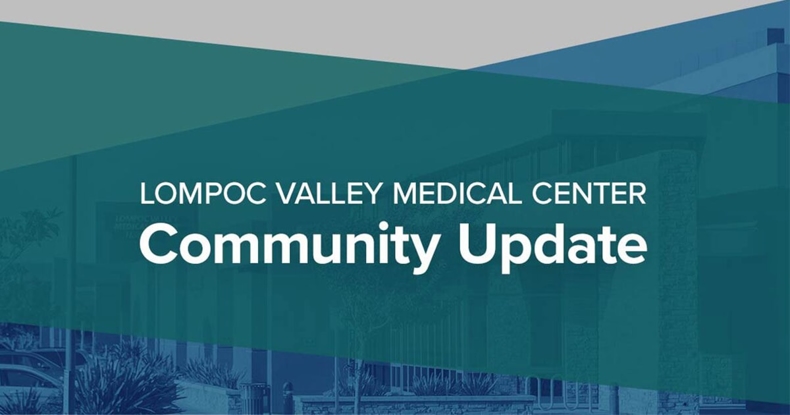“Code Stroke” Program Helping Keep Patients Local
- Category: LVMC Updates
- Posted On:
- Written By: LVMC

Last August, a 62-year-old Lompoc woman arrived at the Emergency Department showing symptoms of an ischemic stroke. She was quickly assessed and treated for stroke by medical staff.
Once stabilized, we administered Alteplase, or Tissue Plasminogen Activator (t-PA), a medicine used to decrease the chances of permanent damage from stroke. The woman was then transported to Santa Barbara Cottage Hospital when she needed advanced treatment by a neurosurgeon specialist.
Because of her initial ED treatment, she recovered well, worked with therapy services, and was discharged back to her home rather than to a long-term care facility.
Two months earlier, a 26-year-old man came to the LVMC emergency department with the left side of his face drooping and weakness in his left side. He was diagnosed with a middle cerebral artery stroke, or MCA. During his medical assessment, he was given t-PA. The man was also transferred to Cottage for additional advanced care. He recovered and was able to return home – mainly because of the initial actions and care in the LVMC Emergency Department.
These are just two of the more than 500 Lompoc Valley residents treated for various levels of stroke-like symptoms in the past four years since LVMC became designated as an Acute Stroke-Ready hospital.
That designation came after LVMC created a “Code Stroke” program and began using a computerized mobile robot to allow visual consultation on stroke cases with teleneurologists associated with the physician-owned company, Vituity.
The robot program was prompted by statistics showing that stroke is among the leading causes of death in Santa Barbara County. Before using Code Stroke and the telemedicine robot, almost every patient coming to LVMC while suffering from stroke-like symptoms had to immediately be transported to larger hospitals with full-time neurologists on staff.
For many patients, that delay in getting treatment while traveling from Lompoc to Santa Barbara was troublesome. With a stroke, the adage is “Time is Brain,” meaning the faster a person receives treatment for an acute ischemic stroke, the better the neurologic outcome. At LVMC, any patient coming in with stroke-like symptoms – and a “last known well time” of six hours or less is processed as a Code Stroke patient. Half of those patients are generally ruled out as suffering from a stroke during the extensive Code Stroke assessment.
“This program has been a tremendous benefit to the community,” says Chief Nursing Officer Yvette Cope. “Without this certification and the dedication and actions of all staff involved in the program, 237 patients would have had to be transferred to a higher level of care outside the community.”
Patients generally fare better in the long term if they are treated within three hours of the start of stroke symptoms. One of the key treatments is the use of a t-PA.
“Treatment with intravenous t-PA within three hours of the onset of Acute Ischemic Stroke is associated with improved clinical outcomes,” Cope explains. “Rapid assessment is critical. Since its inception, LVMC’s Stroke Program has resulted in tremendous outcomes in the well-being of patients who have presented with stroke-like symptoms … This t-PA is lifesaving, but it’s also quality of life. You have a better likelihood of not being physically disabled and of being able to talk and walk if you receive t-PA.”
When a patient comes via ambulance to the emergency department with stroke symptoms, “Code Stroke” is called overhead at the hospital, if a patient is found to have a new onset of at least one of five symptoms in the previous six hours, including sudden, severe headache with unknown cause or sudden numbness or weakness of the face, arm or leg, among others.
A specialized Code Stroke team with staff from the ER, lab, diagnostic imaging, cardiopulmonary services, and other departments responds to the code call.
“Everyone is all hands on deck,” Cope says. “It’s top priority, every single time. Everybody knows their part. Everybody knows ‘time is brain.’”
On average, about 20 “Code Stroke” calls occur every month. Of the patients treated for stroke in the past four years, 49 have received t-PA. At the beginning of the program, the “door to needle” time was 76.4 minutes from the time the patient arrived until t-PA was administered. The Code Stroke team has that timeframe narrowed to 44.8 minutes now, compared to the national healthcare timeframe goal of 60 minutes.
“Before we started this program, we gave five doses of t-PA in the ten years prior,” Cope notes. “Because of this partnership, having neurology in the ER, a majority of patients either went back to their original physical state or are even better. It’s amazing what the stroke program and specialty designation have accomplished. This t-PA is not only life-saving, but it’s also quality of life.”



